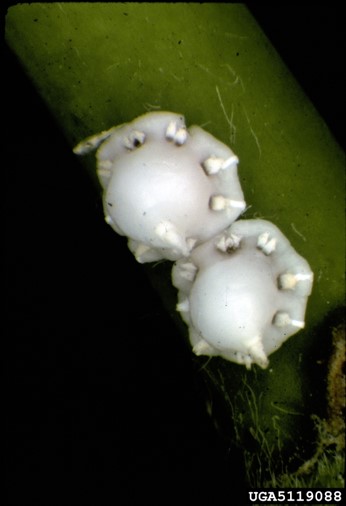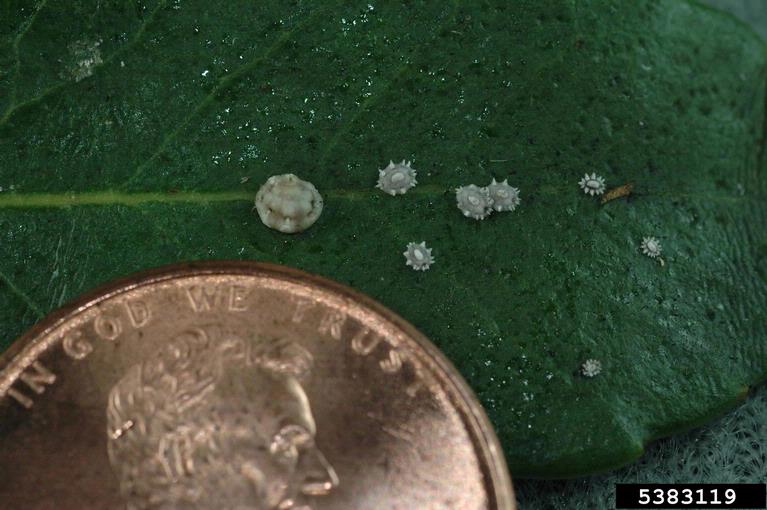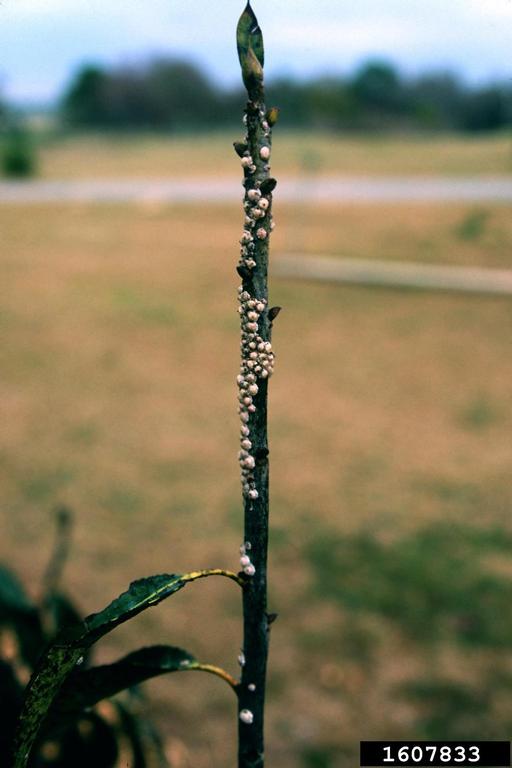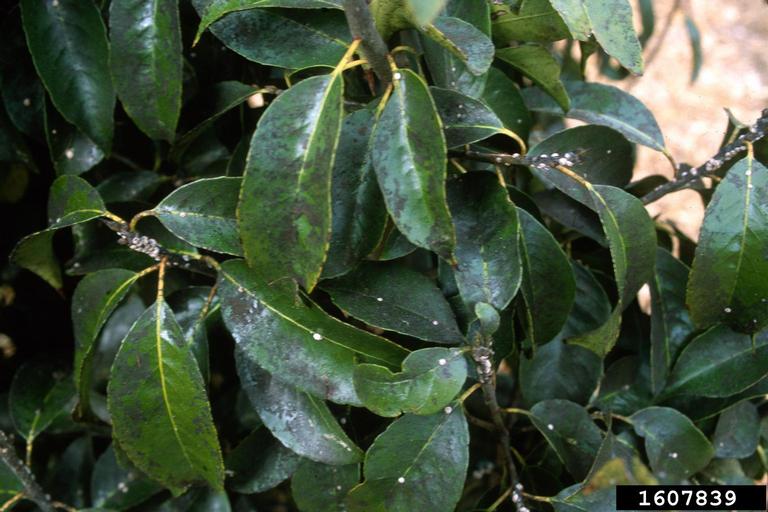Scale insects are very common pests of landscape trees and shrubs yet are often overlooked when scouting. They can, however, be responsible for chlorosis, branch dieback, or, ultimately, death of the plant. Wax scales fall into the soft scale group as they produce soft, cottony, powdery, or waxy covers that cannot be separated from the scale body. Indian wax scale (Ceroplastes ceriferus) (Fig. 1) and Florida wax scale (Ceroplastes floridensis) (Fig. 2) are the common wax scale species that occur in Georgia. The Indian wax scale is prevalent in the eastern U.S. from Florida to Maryland, whereas the Florida wax scale is found from New York to Florida and New Mexico in the west.

General description and biology
Females of wax scale insects are brownish-purple or reddish-brown with white or pinkish-white wax covering the body. Males are not present. Adult females are about 1/4 inch long. The wax produced by females is often sticky. The females lay pale-purple, ovoid-shaped eggs under scale cover (Fig. 3). Females of the Indian wax scale lay from 1,200 to 2,000 eggs. The eggs are laid during late winter and early spring. The eggs hatch into the first nymphal stage, often referred to as crawlers. Egg hatch occurs from mid-May to early June in Georgia. Wax scales often settle on the upper surface of leaves as crawlers but move down to the stem later. The crawlers are pinkish-red or red and flat and have functional legs. Once the crawlers settle on the stem, they molt into the second instars by inserting their piercing and sucking tube-like mouthparts. Once the mouthparts are inserted into plant tissue, they hardly move from that spot and lose their legs. The second instars subsequently molt into third instars. Both the second and third instars secrete waxy material, covering their body. The second instars have a tiny star-shaped appearance (Fig. 2), whereas the third instars resemble a cameo pin and, thus, are referred to as the cameo stage (Fig. 4). The nymphs mature through the summer months. The third instars molt into adult females. They are covered with a gummy, white wax that looks like a thick, dunce cap (Figs. 1 and 5). There is one generation yearly in Georgia, especially central to North Georgia. Multiple generations of wax scale insects are possible in southern Georgia. Adult females overwinter on the bark.



Damage
Nymphs and females feed on sugars by inserting the piercing and sucking mouthparts into the phloem vessels of the plant. If the infestation is severe, they suck up a large amount of nutrients vital to the growth and development of the plant, which can cause leaf discoloration, cause heavy leaf drop, and ultimately branch dieback. These affected plants may die in certain situations. Severely infested host plants often appear black (Fig. 6) as the wax scale insects excrete excessive amounts of honeydew (the sugary substance they don’t need), where a black sooty mold fungus grows. The sooty mold completely changes the appearance of the host plant with a black coating.


Host plants
Although wax scales feed on many shrubs and trees, such as hemlock, azalea, blueberry, camellia, citrus, fig, eugenia, gumbo-limbo, yaupon, jasmine, mulberry, pear, persimmon, plum, sabodilla, and turkscap, they prefer Japanese holly, Chinese holly, euonymus, boxwood, firethorn, spirea, barberry, and flowering quince.
Monitoring
Beginning in May, examine female wax scales on leaves and twigs at one to two-week intervals and determine when the eggs hatch. Crawlers begin to emerge in early summer in Georgia. The increased activity of foraging bees, wasps, hornets, and ants on dense shrubs may indicate heavy honeydew production and severe wax scale infestation. Look on twigs and small branches for all wax scale insect stages.
Management
Before installing hosts in the landscape, scout for any wax scale insects on them. If the wax scale insect infestation is found on twigs, remove heavily infested twigs or branches to reduce the number of insects on the plant. Wax scale can be physically removed by handpicking if the infestation is light. Avoid planting susceptible hosts, such as ‘Burford’ holly. A study showed that certain species of hollies, such as Ilex buergeri, Ilex crenata, Ilex glabra, Ilex myrtifolia, Ilex verticillata, and Ilex vomitoria have demonstrated a degree of resistance to wax scales.
The thick layer of wax on the nymphs (except crawlers) and females protects them from exposure to applied insecticides. The thickness of the wax is greater for females than for nymphs. Crawlers have no wax covering and are the most susceptible stage of the wax scale insect.
A thorough spray of contact insecticides, such as horticultural oil, insecticidal soap, or synthetic insecticide (e.g., pyrethroids, such as permethrin, bifenthrin, etc.) is necessary, especially when the crawlers are present on the twig for effective control. Contact insecticides can harm beneficial insects, such as predators and parasitoids, which can cause problems with resurging secondary pests otherwise regarded as minor pests. Systemic insecticides (e.g., neonicotinoids, such as acetamiprid, thiamethoxam, dinotefuran, etc.) can be soil drenched or injected and can effectively reduce the densities of developing nymphs and females. The dead wax scales may not naturally fall off the twigs, and it may be challenging to determine if the insecticide killed the scales. Squish the wax scale insect, and if no liquid oozes out, that indicates the wax scale insects are dead. Systemic insecticides are generally compatible with biological control agents, such as predators, but they could harm pollinators, such as foraging bees seeking pollen and nectar from the plant. Insect growth regulators, such as pyriproxyfen, novaluron, buprofezin, etc., are also effective control options. They reduce the egg hatch or viability and normal development of the nymphs.
Reading the insecticide label, including the precautionary statements, is critical before using it for wax scale insect control. The insecticide label is the law.
References
Hamon AB, Williams ML. 1984. Arthropods of Florida and neighboring land areas, Vol. 2. Florida Department of Agricultural and Consumer Services, Division of Plant Industry.
Hodges GS, Ruter JR, Braman SK. 2000. Susceptibility of Ilex species, hybrids and cultivars to Florida wax scale. Journal of Environmental Horticulture 19: 32-36.